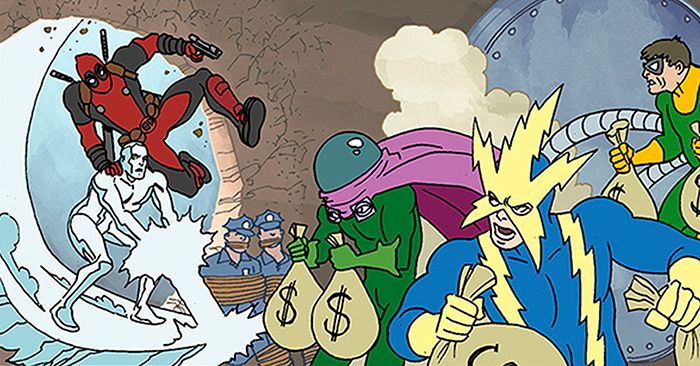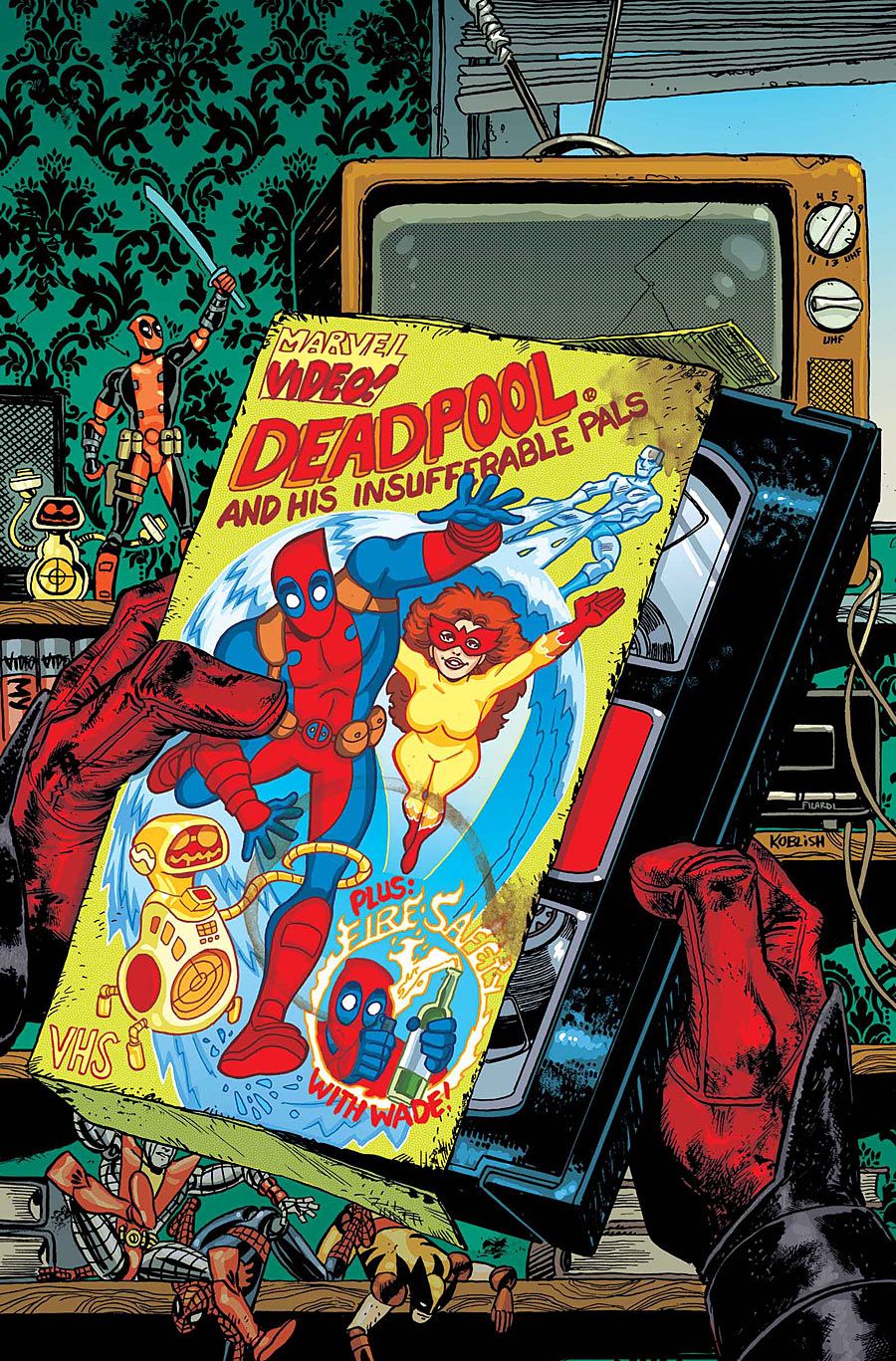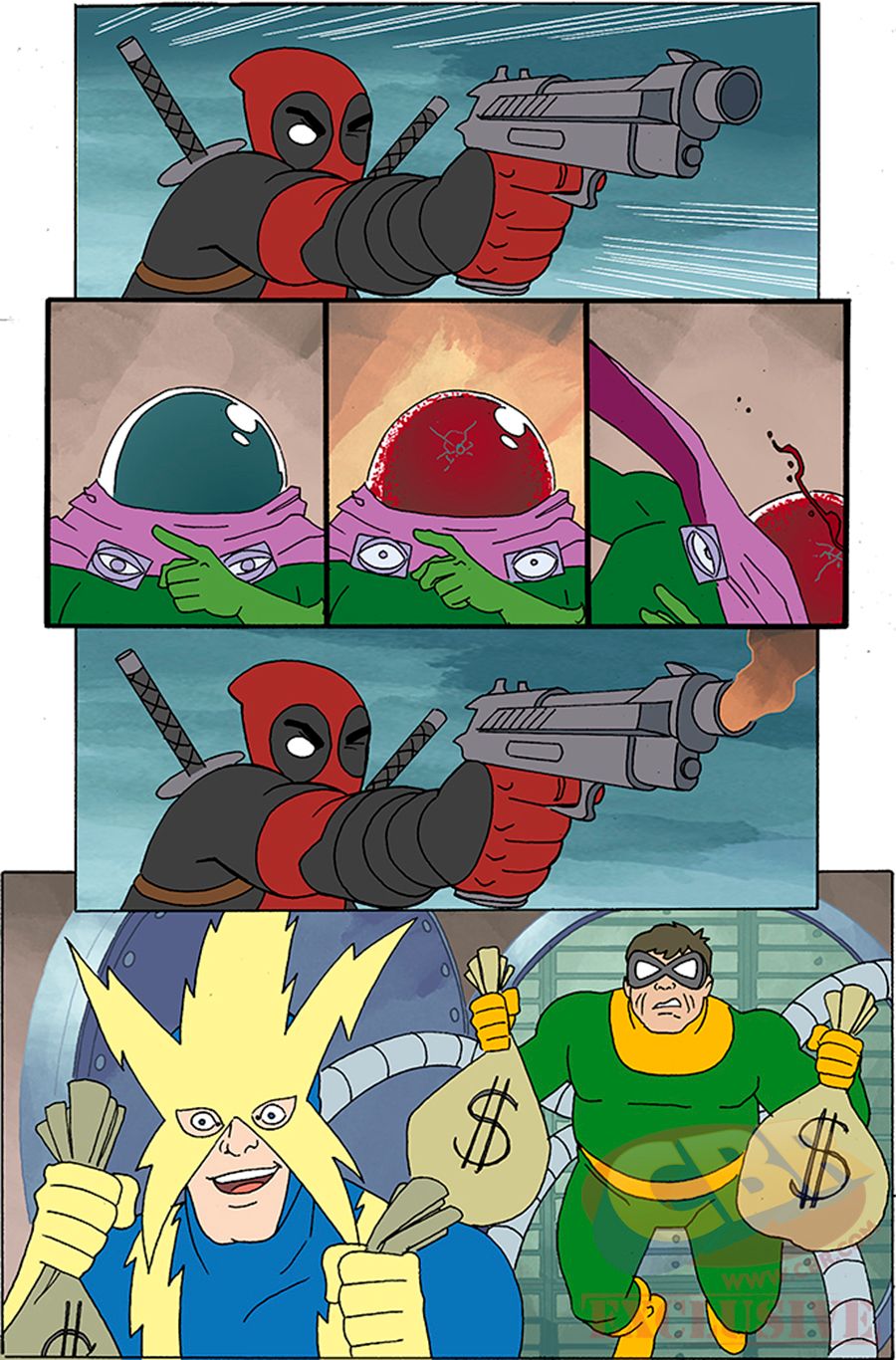This September, Deadpool is venturing into totally uncharted territory: an '80s Saturday morning cartoon. No, the Merc with a Mouth isn't getting a straight-to-VHS release. True to DP's anarchic persona, his animated adventure is jumping to a totally different medium: comics. That's right, this fall's "Deadpool Annual" #1 from writers Gerry Duggan and Brian Posehn and artist Scott Koblish will capture all that Saturday morning magic and transplant it right onto the printed page. This issue posed a number of unique challenges, like Koblish reinventing his art style, and will delightfully skewer the cartoons many of us remember from decades past.
RELATED: Duggan's "Deadpool" Goes Back to the Future, Gets Drafted into "Civil War II"
This week in X-POSITION, "Deadpool Annual" writer Gerry Duggan and artist Scott Koblish answer your questions about the medium-busting retro-style Wade Wilson adventure.
CBR News: Welcome to X-POSITION, Scott! And welcome back, Gerry! I'll start things off with a few questions about this radical annual. This is an issue of "Deadpool" done in the style of an early '80s Saturday morning cartoon. Was there any hesitation about embarking on this wild ride?
Gerry Duggan: Nah.
Scott Koblish: Hesitation is for people who don't work on Deadpool.
What are the biggest differences between storytelling for comics and storytelling for an '80s-style cartoon -- even a fake one like the one Deadpool stars in?
Duggan: Well, this is a comic. So it has to work as a comic first and foremost. I think Scott can say more about the art, which...
Koblish: I worked briefly in animation, and I worked with some of the people who had worked on shows like "G.I. Joe" in the '80s, and I learned a lot from them, so I just tried to apply it to the comic. The main differences between animation and comics is that nothing moves, and we lose sound, but those distinctions are kinda lost on a reader, so I leaned on the manner in which things were drawn. Television animation from that time period has a flat, thin line around it and no shading. All of the male super-characters were drawn bulbous, thick and rounded, in a vague shorthand for muscle. I treated each panel like a key-frame, as if I were doing animation layouts.
What led you to decide to make the interior art look like animation stills from this "lost" episode? Was creating a whole new style difficult?
Koblish: I loved what Gerry and Brian came up with. I can't remember if I took the style distinction as implied in the concept and then kind of ran with it, or if someone on the project suggested it, but the idea that I could use the art style to be the Uber-Joke became more and more important to me the longer I sat with it. I try to make all these stylistic shifts look easy, but it's actually ninja-level hard. [Laughs] I pushed for flat colors on the figures and a more watercolor/painterly aspect to the backgrounds. [Colorist] Christopher Sotomayor really pulled through on that, and did an excellent job.
Are there any panels or pages or sequences in particular that readers should look out for, ones that you think really sell the ideas of a cartoon in comic form?
Koblish: We did some "re-use" jokes. In television animation, especially from this era, there was a really hard push to re-use images repeatedly in an effort to save time and energy. I threw in a little bit of that. I'm also really proud of the fact that we essentially did the animated version of "Kraven's Last Hunt."
This issue will pit Deadpool against the Sinister Six, classic Spider-Man villains. What led to their involvement, as opposed to giving some of Deadpool's foes the '80s cartoon treatment?
Duggan: Deadpool and his loose morals were the sole intrusion. As fun as '80s versions of those rogues would be -- this is the bad house guest intruding. It's sort of -- he comes in and basically gets the TV show cancelled just by being there. It's not just that he's bad. It's the corrupting influence. Plus, it's always fun to play with the Sinister Six. We asked Posehn to squeeze in some time for this one. If readers have half as much fun as we did, everyone will be in for a good time.
Deadpool's already had great success with Marvel's digital-first Infinite Comics. Was there ever an urge to hold off on this idea and do it as an Infinite Comic and incorporate actual animated elements?
Duggan: Infinite Comics require extra time and TLC.
Koblish: If the annual sells well, I'm ready to fully animate the whole episode. 22 minutes of content, at 24 frames a second, I should be done by the time the third "Deadpool" movie comes out.
Now let's turn to a few questions from our readers, starting with one from Kamose1234 about the issue's team-up aspect.
Deadpool has had some great team ups in his career (I loved "The Good, The Bad and The Ugly" with Logan and Steve!!!) but in the last year Wade has had more than usual with Cable, Gambit, Spider-Man, his Mercs for Money, and the Uncanny Avengers to name a few. What sets this one apart?
Duggan: Era and tone more. The early morning time slot of a cartoon means Deadpool is even more unwelcome than usual.
Koblish: This one was meant to be read in your pajamas, in the morning, in the basement, in front of the television, while your parents sleep it off.
And here's another from Kamose1234 about the cartoon this comic's parodying.
Will readers of the annual have to be familiar with the "Spider-Man and his Amazing Friends" television show to fully understand the story? I'm aware of the 1983 cartoon which it draws influence from, but that show aired when my parents were my age and I've only seen the last decades few Spider-Man movies and shows.
Duggan: Nah. You'll be able to enjoy dropping Deadpool into a simpler time. The fun of this is a pitch perfect "What if Deadpool's morals intrude on an 80s cartoon for kids?"
Next, MiddlePegasus has a question about the jokes.
Are there any fun tropes in particular that you get to skewer in this annual, either with the dialogue or art? Which ones were your favorites to lampoon?
Duggan: Well, Scott and the colorist have absolutely matched the art. it's absolutely incredible. Without spoiling much, it's probably one of our more violent offerings. That's really saying something. If this were actually a TV show, it would only have lasted this one episode before people were fired and possibly jailed.
Koblish: The blood, oh my heavens, the blood.
You never saw blood on "G.I. Joe," that's for sure! Now we have a Q from YeahX3 about some of Deadpool's unlikely pals.
How big of a role do Iceman and Firestar have in this annual? I love those characters and can't wait to see Deadpool interact with them.
Duggan: Honestly, that is really the heart of the issue. To a certain extent, that is the cornerstone of all our Deadpool stories: what is the chemical reaction when you introduce Deadpool to a situation? Spidey/Firestar/Iceman have their chemistry. This is a story about Iceman and Firestar losing Spidey and his moral compass, and adding Deadpool, who of course, doesn't exactly have one. (He has one, but his needle isn't magnetized) I suppose one minor difference between our "What If" comic and the animated show is that our Iceman is a young gay man. It's not a gag of course, but his sexuality is referenced in our comic.
And we'll close out this look at the "Deadpool Annual" with two questions from Raymond.
One of the things I remember most about "Spider-Man and his Amazing Friends" was Ms. Lion, Aunt May's dog. What're the odds of us seeing Ms. Lion in this issue? Or does Deadpool perhaps have his own animal friend?
Duggan: Honestly, she'll be lucky to get out alive. She doesn't have a big role to play, but she's got a cameo.
Koblish: We're saving the real twists and turns with Ms. Lion for the main book, wherein she returns as a mutated Griffin-like creature who harbors a secret, unrequited love for Wade. Or I might be making that up.
We've so far seen Scott collaborate with Gerry and Brian on "Deadpool" comics that take place throughout the decades, and now one that takes place in a "cartoon." Are there other mediums or styles coming up next?
Duggan: The "Inventory issues" are lightning in a bottle. [Editor] Jordan D. White pitched us the idea to do a fake inventory issue while Tony Moore was drawing the first issue [in 2012] -- something to break up the arcs. Gags aside, they're valuable in seeding ideas and creating a backwards history for Deadpool as we work our way forward in time. The idea happened to connect with Brian and I -- we had an idea that was never ever going to happen. We knew it was not going to happen, but we kept pitching "Legends Of Drunk Iron Man: The Armored Avengers Most Intoxicating Tales." Jordan got Scott and Val [Staples] and the rest was history. "2099" was a big and crazy enough story that we put the inventory issues on hiatus, but we have more ideas for comics of yesteryear that will get the Deadpool treatment. So many of your favorite gags from those comics were probably drawn in by Scott.
Koblish: Oh, there are as many possibilities available as there are different styles within the medium: Western, Barbarian, Romance, Mystery, Sci-Fi... maybe one where it's a black and white tonework Manga Deadpool. I would love to see Irene Y. Lee do a "Chibi" Deadpool book. The one thing I've learned about Deadpool is that we can do really deep meta-work with him, stuff that goes right to the very heart of our common conceptions of the graphic novel medium, and he easily skates right through it. There might be a way to break him, but I haven't found it yet.
Special thanks to Gerry Duggan and Scott Koblish for taking part in this week's X-POSITION!
Stay tuned to CBR for information on the next X-POSITION!





